An Analytical–Numerical Model for Determining “Drill String–Wellbore” Frictional Interaction Forces
Abstract
1. Introduction
- -
- providing the required torque on bits;
- -
- determination of the real axial loading on the bottom hole;
- -
- assessment of the drilling energy balance;
- -
- assessment of the drill string guaranteed resource;
- -
- -
- -
- -
- directed formation and transformation of product properties during manufacturing [29];
- development of a “drill string–well bore” contact and friction force mathematical model to determine the aforementioned forces in sections;
- development of numerical models of longitudinal and torsional vibrations for drill strings with pipes of various materials for conditionally vertical and inclined wells and carrying out their numerical implementation.
2. Materials and Methods
2.1. Drill String Pipe Materials
- -
- aluminum deformed alloy D16T (Al–Cu–Mg system) Interstate Standard GOST 4784–2019; Aluminum and wrought aluminum alloys. Grades. (EN 573–3:2013, NEQ), (ISO 209:2007, NEQ). Eurasian Council for Standardization, Metrology and Certification: Minsk, BY, 2019;
- -
- titanium deformed alloy VT6 (is an alpha-beta titanium alloy) State Standard GOST 19807–91; Wrought titanium and titanium alloys. Grades. Standardization and Metrology Committee: Moscow, USSR, 1992;
- -
- structural alloy steel 36G2S Interstate Standard GOST 51245-99; Steel universal drill rods. General spesifscations. Eurasian Council for Standardization, Metrology and Certification: Minsk, BY, 2017.
2.2. Methodology of Computer Modeling of a Column of Pipes
2.3. Methodology of Mathematical Modeling
- -
- for the 2nd half-wave section:
- -
- for the 1st half-wave section:
- -
- for the 2nd half-wave section:
3. Results and Discussion
4. Conclusions
Author Contributions
Funding
Data Availability Statement
Acknowledgments
Conflicts of Interest
References
- Ma, T.; Chen, P.; Zhao, J. Overview on vertical and directional drilling technologies for the exploration and exploitation of deep petroleum resources. Géoméch. Geophys. Geo-Energy Geo-Resour. 2016, 2, 365–395. [Google Scholar] [CrossRef]
- El Sabeh, K.; Gaurina-Međimurec, N.; Mijić, P.; Medved, I.; Pašić, B. Extended-Reach Drilling (ERD)—The Main Problems and Current Achievements. Appl. Sci. 2023, 13, 4112. [Google Scholar] [CrossRef]
- Tong, H.; Shao, Y. Mechanical Analysis of DS in Horizontal Directional Drilling. Appl. Sci. 2022, 12, 3145. [Google Scholar] [CrossRef]
- Jeong, J.; Lim, C.; Park, B.-C.; Bae, J.; Shin, S.-c. Multi-Objective Optimization of Drilling Trajectory Considering Buckling Risk. Appl. Sci. 2022, 12, 1829. [Google Scholar] [CrossRef]
- Gu, Y.; Huang, W.; Gao, D. Directional Drilling Limits Analysis Based on Downhole Drill String Mechanics for Shale Gas Cluster Well Engineering. Arab. J. Sci. Eng. 2022, 47, 11255–11267. [Google Scholar] [CrossRef]
- Chudyk, I.I.; Dudych, I.F.; Sudakova, D.A.; Voloshyn, Y.D.; Bogoslavets, V.V. Influence of Drilling Mud Pulsations on Well Cleanout Efficiency. Nauk. Visnyk Natsionalnoho Hirnychoho Universytetu 2023, 2023, 48–53. [Google Scholar] [CrossRef]
- Kessai, I.; Benammar, S.; Doghmane, M.Z.; Tee, K.F. Drill Bit Deformations in Rotary Drilling Systems under Large-Amplitude Stick-Slip Vibrations. Appl. Sci. 2020, 10, 6523. [Google Scholar] [CrossRef]
- Grydzhuk, J.; Dzhus, A.; Yurych, A.; Yurych, L.; Dorokhov, M.; Livinskyi, A. Improving the technique for assessing the condition and predicting the wear of the rock destruction tool equipment. East.-Eur. J. Enterp. Technol. 2022, 4, 103–109. [Google Scholar] [CrossRef]
- Chen, X.; Yang, J.; Gao, D. Drilling Performance Optimization Based on Mechanical Specific Energy Technologies; Drilling; Samsuri, A., Ed.; IntechOpen Limited: London, UK, 2018. [Google Scholar] [CrossRef]
- Lashari, S.; Takbiri-Borujeni, A.; Fathi, E. Drilling performance monitoring and optimization: A data-driven approach. J. Petrol. Explor. Prod. Technol. 2019, 9, 2747–2756. [Google Scholar] [CrossRef]
- Sridharan, C.; Suresh Kumar, G. Drilling Efficiency Improvement and Rate of Penetration Optimization by Machine Learning and Data Analytics. Int. J. Math. Eng. Manag. Sci. 2020, 5, 381–394. [Google Scholar] [CrossRef]
- Khajiyeva, L.A.; Andrianov, I.V.; Sabirova, Y.F.; Kudaibergenov, A.K. Analysis of Drill-String Nonlinear Dynamics Using the Lumped-Parameter Method. Symmetry 2022, 14, 1495. [Google Scholar] [CrossRef]
- Huang, F.; Yang, J.; Li, B.; Gan, L.; Feng, Q. Study on dynamic characteristics of drill string in deep-water riserless drilling. Adv. Mech. Eng. 2023, 15, 16878132221142113. [Google Scholar] [CrossRef]
- O’Reilly, O.M. Kirchhoff’s Rod Theory. In Modeling Nonlinear Problems in the Mechanics of Strings and Rods; Interaction of Mechanics and Mathematics; Springer: Cham, Switzerland, 2017; pp. 187–268. [Google Scholar] [CrossRef]
- Ghasemloonia, A.; Rideout, D.G.; Butt, S.D. A review of drillstring vibration modeling and suppression methods. J. Pet. Sci. Eng. 2015, 131, 150–164. [Google Scholar] [CrossRef]
- Prysyazhnyuk, P.; Molenda, M.; Romanyshyn, T.; Ropyak, L.; Romanyshyn, L.; Vytvytskyi, V. Development of a hardbanding material for drill pipes based on high-manganese steel reinforced with complex carbides. Acta Montan. Slovaca 2022, 27, 685–696. [Google Scholar] [CrossRef]
- Gajdzik, B.; Sroka, W. Analytic study of the capital restructuring processes in metallurgical enterprises around the world and in Poland [Analitički studij kapitalnog restrukturiranja procesa metalurških tvrtki u svijetu i poljskoj]. Metalurgija 2012, 51, 265–268. [Google Scholar]
- Teodoriu, C.; Bello, O. An Outlook of Drilling Technologies and Innovations: Present Status and Future Trends. Energies 2021, 14, 4499. [Google Scholar] [CrossRef]
- Grydzhuk, J.; Chudyk, I.; Slabyi, O.; Mosora, Y.; Kovbaniuk, M.; Krynke, M. Mathematical modeling of the stress-strain state of the annular preventer seal using the theory of reinforced shells. Prod. Eng. Arch. 2022, 28, 375–380. [Google Scholar] [CrossRef]
- Shlyun, N.V.; Gulyayev, V.I. Buckling of a drill-string in two-sectional bore-holes. Int. J. Mech. Sci. 2020, 172, 105427. [Google Scholar] [CrossRef]
- Vytyaz, O.; Chudyk, I.; Mykhailiuk, V. Study of the effects of drilling string eccentricity in the borehole on the quality of its cleaning. In New Developments in Mining Engineering; CRC Press: Boca Raton, FL, USA, 2015; pp. 591–595. [Google Scholar] [CrossRef]
- Onysko, O.; Borushchak, L.; Kopei, V.; Lukan, T.; Medvid, I.; Vryukalo, V. Computer Studies of the Tightness of the Drill String Connector Depending on the Profile of Its Tapered Thread. Lect. Notes Netw. Syst. 2020, 128, 720–729. [Google Scholar] [CrossRef]
- Kopei, V.; Onysko, O.; Panchuk, V.; Pituley, L.; Schuliar, I. Influence of Working Height of a Thread Profile on Quality Indicators of the Drill-String Tool-Joint. In Advanced Manufacturing Processes III; InterPartner 2021; Tonkonogyi, V., Ivanov, V., Trojanowska, J., Oborskyi, G., Pavlenko, I., Eds.; Lecture Notes in Mechanical Engineering; Springer: Cham, Switzerland, 2022; pp. 395–404. [Google Scholar] [CrossRef]
- Chudyk, I.; Poberezhny, L.; Hrysanchuk, A.; Poberezhna, L. Corrosion of drill pipes in high mineralized produced waters. Procedia Struct. Integr. 2019, 16, 260–264. [Google Scholar] [CrossRef]
- Vynar, V.A.; Dovhunyk, V.M.; Student, M.M. Methodical specific features of tribocorrosion investigations. Mater. Sci. 2011, 46, 633–639. [Google Scholar] [CrossRef]
- Pokhmurskii, V.I.; Vynar, V.A.; Vasyliv, C.B.; Ratska, N.B. Effects of hydrogen exposure on the mechanical and tribological properties of α-titanium surfaces. Wear 2013, 306, 47–50. [Google Scholar] [CrossRef]
- Shats’kyi, I.P.; Makoviichuk, M.V. Contact interaction of crack lips in shallow shells in bending with tension. Mater. Sci. 2005, 41, 486–494. [Google Scholar] [CrossRef]
- Andreikiv, O.Y.; Dolins’ka, I.Y.; Shtoiko, I.P.; Raiter, O.K.; Matviiv, Y.Y. Evaluation of the Residual Service Life of Main Pipelines with Regard for the Action of Media and Degradation of Materials. Mater. Sci. 2019, 54, 638–646. [Google Scholar] [CrossRef]
- Kusyi, Y.; Stupnytskyy, V.; Onysko, O.; Dragašius, E.; Baskutis, S.; Chatys, R. Optimization synthesis of technological parameters during manufacturing of the parts. Eksploat. I Niezawodn. Maint. Reliab. 2022, 24, 655–667. [Google Scholar] [CrossRef]
- Petrakov, Y.; Danylchenko, M. A Time-Frequency Approach to Ensuring Stability of Machining by Turning. East.-Eur. J. Enterp. Technol. 2022, 6, 85–92. [Google Scholar] [CrossRef]
- Danylchenko, Y.; Storchak, M.; Danylchenko, M.; Petryshyn, A. Cutting Process Consideration in Dynamic Models of Machine Tool Spindle Units. Machines 2023, 11, 582. [Google Scholar] [CrossRef]
- Barandych, K.S.; Vysloukh, S.P.; Antonyuk, V.S. Ensuring Fatigue Life of Parts During Finish Turning with Cubic Boron Nitride Tools. J. Superhard Mater. 2018, 40, 206–215. [Google Scholar] [CrossRef]
- Bembenek, M.; Dzienniak, D.; Dzindziora, A.; Sułowski, M.; Ropyak, L. Investigation of the Impact of Selected Face Milling Parameters on the Roughness of the Machined Surface for 1.4301 Steel. Adv. Sci. Technol. Res. J. 2023, 17, 299–312. [Google Scholar] [CrossRef]
- Petrakov, Y.; Danylchenko, Y.; Sapon, S.; Sikailo, M. Surface Relief Formation in Peripheral End Milling. In Advances in Design, Simulation and Manufacturing VI; Notes in Mechanical Engineering; Springer: Cham, Switzerland, 2023; pp. 316–326. [Google Scholar] [CrossRef]
- Smokvyna, V.V.; Lavrinenko, V.I.; Ilnytska, H.D. Defectiveness of Low Strength Synthetic Diamond Grains: Negative and Positive Aspects in Case of Using Them in a Grinding Tool. J. Superhard Mater. 2023, 45, 306–315. [Google Scholar] [CrossRef]
- Onysko, O.; Medvid, I.; Panchuk, V.; Rodic, V.; Barz, C. Geometric Modeling of Lathe Cutters for Turning High-Precision Stainless Steel Tapered Threads. In Advances in Design, Simulation and Manufacturing IV. DSMIE 2021; Ivanov, V., Trojanowska, J., Pavlenko, I., Zajac, J., Peraković, D., Eds.; Lecture Notes in Mechanical Engineering; Springer: Cham, Switzerland, 2021; Volume 1, pp. 472–480. [Google Scholar] [CrossRef]
- Medvid, I.; Onysko, O.; Panchuk, V.; Pituley, L.; Schuliar, I. Kinematics of the Tapered Thread Machining by Lathe: Analytical Study. In Proceedings of the Advanced Manufacturing Processes II 2020; Tonkonogyi, V., Ivanov, V., Trojanowska, J., Oborskyi, G., Grabchenko, A., Pavlenko, I., Edl, M., Kuric, I., Dasic, P., Eds.; Lecture Notes in Mechanical Engineering; Springer: Cham, Switzerland, 2021; pp. 555–565. [Google Scholar] [CrossRef]
- Trembach, B.O.; Sukov, M.G.; Vynar, V.A.; Trembach, I.O.; Subbotina, V.V.; Rebrov, O.Y.; Rebrova, O.M.; Zakiev, V.I. Effect of Incomplete Replacement of Cr for Cu in the Deposited Alloy of Fe–C–Cr–B–Ti Alloying System with a Medium Boron Content (0.5% wt.) on its Corrosion Resistance. Metallofiz. I Noveishie Tekhnologii 2022, 44, 493–513. [Google Scholar] [CrossRef]
- Tarelnik, V.B.; Gaponova, O.P.; Konoplyantschenko, E.V.; Yevtushenko, N.S.; Gerasimenko, V.A. Analysis of the structural state of the surface layer after electro-erosive alloying. II. Peculiarities of the formation of electroerosive coatings on special steels and stops by hard wear-resistant and soft antifriction materials. Metallofiz. I Noveishie Tekhnologii 2018, 11, 795–815. [Google Scholar] [CrossRef]
- Ropyak, L.; Shihab, T.; Velychkovych, A.; Bilinskyi, V.; Malinin, V.; Romaniv, M. Optimization of Plasma Electrolytic Oxidion Technological Parameters of Deformed Aluminum Alloy D16T in Flowing Electrolyte. Ceramics 2023, 6, 146–167. [Google Scholar] [CrossRef]
- Ropyak, L.; Shihab, T.; Velychkovych, A.; Dubei, O.; Tutko, T.; Bilinskyi, V. Design of a Two-Layer Al–Al2O3 Coating with an Oxide Layer Formed by the Plasma Electrolytic Oxidation of Al for the Corrosion and Wear Protections of Steel. Prog. Phys. Met. 2023, 24, 319–365. [Google Scholar] [CrossRef]
- Shatskyi, I.; Makoviichuk, M.; Ropyak, L.; Velychkovych, A. Analytical Model of Deformation of a Functionally Graded Ceramic Coating under Local Load. Ceramics 2023, 6, 1879–1893. [Google Scholar] [CrossRef]
- Pashechko, M.I.; Shyrokov, V.V.; Duryahina, Z.A.; Vasyliv, K.B. Structure and corrosion-mechanical properties of the surface layers of steels after laser alloying. Mater. Sci. 2003, 39, 108–117. [Google Scholar] [CrossRef]
- Bembenek, M.; Prysyazhnyuk, P.; Shihab, T.; Machnik, R.; Ivanov, O.; Ropyak, L. Microstructure and Wear Characterization of the Fe–Mo–B–C—Based Hardfacing Alloys Deposited by Flux-Cored Arc Welding. Materials 2022, 15, 5074. [Google Scholar] [CrossRef]
- Prysyazhnyuk, P.; Di Tommaso, D. The thermodynamic and mechanical properties of Earth-abundant metal ternary boride Mo2(Fe,Mn)B2 solid solutions for impact- and wear-resistant alloys. Mater. Adv. 2023, 4, 3822–3838. [Google Scholar] [CrossRef]
- Trembach, B.; Balenko, O.; Davydov, V.; Brechko, V.; Trembach, I.; Kabatskyi, O. Prediction the Melting Characteristics of Self-Shielded Flux Cored arc Welding (FCAW–S) with Exothermic Addition (CuO–Al). In Proceedings of the 2022 IEEE 4th International Conference on Modern Electrical and Energy System, MEES 2022, Kremenchuk, Ukraine, 20–23 October 2022; pp. 1–6. [Google Scholar] [CrossRef]
- Prysyazhnyuk, P.M.; Shihab, T.A.; Panchuk, V.H. Formation of the Structure of Cr3C2–MNMts 60-20-20 Cermets. Mater. Sci. 2016, 52, 188–193. [Google Scholar] [CrossRef]
- Pryhorovska, T.O.; Chaplinskiy, S.S.; Kudriavtsev, I.O. Finite element modelling of rock mass cutting by cutters for PDC drill bits. Shiyou Kantan Yu Kaifa/Pet. Explor. Dev. 2015, 42, 812–816. [Google Scholar] [CrossRef]
- Jinping, Y.; Deyong, Z.; Yuanxiu, S.; Yin, Z. Simulation and Experimental Study of the Rock Breaking Mechanism of Personalized Polycrystalline Diamond Compact Bits. J. Eng. Sci. Technol. Rev. 2020, 13, 122–131. [Google Scholar] [CrossRef]
- Tatsiy, R.; Stasiuk, M.; Pazen, O.; Vovk, S. Modeling of Boundary-Value Problems of Heat Conduction for Multilayered Hollow Cylinder. In Proceedings of the 2018 International Scientific-Practical Conference Problems of Infocommunications. Science and Technology (PIC S&T), Kharkiv, Ukraine, 9–12 October 2018; pp. 21–25. [Google Scholar] [CrossRef]
- Bandura, A.; Skaskiv, O. Boundedness of the L-index in a direction of entire solutions of second order partial differential equation. Acta Et Comment. Univ. Tartu. De Math. 2018, 22, 223–234. [Google Scholar] [CrossRef]
- Tatsiy, R.M.; Pazen, O.Y.; Vovk, S.Y.; Kharyshyn, D.V. Direct method of studying heat exchange in multilayered bodies of basic geometric forms with imperfect heat contact. Naukovyi Visnyk Natsionalnoho Hirnychoho Universytetu 2021, 2021, 60–67. [Google Scholar] [CrossRef]
- Panevnik, D.A.; Velichkovich, A.S. Assessment of the stressed state of the casing of the above-bit hydroelevator. Neftyanoe Khozyaystvo Oil Ind. 2017, 1, 70–73. [Google Scholar]
- Kotsyubynsky, V.; Shyyko, L.; Shihab, T.; Prysyazhnyuk, P.; Aulin, V.; Boichuk, V. Multilayered MoS2/C nanospheres as high performance additives to lubricating oils. Mater. Today Proc. 2019, 35, 538–541. [Google Scholar] [CrossRef]
- Moisyshyn, V.M.; Lyskanych, M.V.; Borysevych, L.V.; Kolych, N.B.; Zhovniruk, R.A. Integral Indicators of Change of Drilling Column Vibration-Criterion for Assessing of Roller Cone Bit Wear. Metallofiz. I Noveishie Tekhnologii 2019, 41, 1087–1102. [Google Scholar] [CrossRef]
- Dutkiewicz, M.; Gołębiowska, I.; Shatskyi, I.; Shopa, V.; Velychkovych, A. Some aspects of design and application of inertial dampers. MATEC Web Conf. 2018, 178, 06010. [Google Scholar] [CrossRef][Green Version]
- Moisyshyn, V.M.; Slabyi, O.O. Creation of the vibroprotective device for adjustment of dynamics of a column of steel drill pipes and a bit. Metallofiz. I Noveishie Tekhnologii 2018, 40, 541–550. [Google Scholar] [CrossRef][Green Version]
- Shats’kyi, I.P.; Shopa, V.M.; Velychkovych, A.S. Development of full-strength elastic element section with open shell. Strength Mater. 2021, 53, 277–282. [Google Scholar] [CrossRef]
- Dutkiewicz, M.; Velychkovych, A.; Shatskyi, I.; Shopa, V. Efficient Model of the Interaction of Elastomeric Filler with an Open Shell and a Chrome-Plated Shaft in a Dry Friction Damper. Materials 2022, 15, 4671. [Google Scholar] [CrossRef]
- Shatskyi, I.; Velychkovych, A. Analytical Model of Structural Damping in Friction Module of Shell Shock Absorber Connected to Spring. Shock Vib. 2023, 2023, 4140583. [Google Scholar] [CrossRef]
- Velichkovich, A.S.; Dalyak, T.M. Assessment of stressed state and performance characteristics of jacketed spring with a cut for drill shock absorber. Chem. Pet. Eng. 2015, 51, 188–193. [Google Scholar] [CrossRef]
- Petlovanyi, M.; Lozynskyi, V.; Saik, P.; Sai, K. Predicting the producing well stability in the place of its curving at the underground coal seams gasification. E3S Web Conf. 2019, 123, 01019. [Google Scholar] [CrossRef]
- Tyrlych, V.; Moisyshyn, V. Predicting remaining lifetime of drill pipes basing upon the fatigue crack kinetics within a pre-critical period. Min. Miner. Depos. 2019, 13, 127–133. [Google Scholar] [CrossRef]
- Moisyshyn, V.; Yacyshyn, V.; Vytyaz, O. The use of the spatial characteristics technique with the view of estimating the explosion wave impact on the stuck drilling string zone. Arch. Min. Sci. 2012, 57, 601–618. [Google Scholar] [CrossRef]
- Gulyayev, V.; Shlyun, N. Influence of friction on buckling of a drill string in the circular channel of a bore hole. Pet. Sci. 2016, 13, 698–711. [Google Scholar] [CrossRef]
- Li, Z.; Zhang, C.; Ren, W.; Ma, J. Study of Radial Vibration Impact on Friction and Torque of Rotary Drill String. Shock Vib. 2020, 2020, 8852530. [Google Scholar] [CrossRef]
- Vytyaz, O.Y.; Hrabovskyy, R.S.; Artym, V.I.; Tyrlych, V.V. Effect of geometry of internal crack-like defects on assessing trouble-free operation of long-term operated pipes of drill string. Metallofiz. I Noveishie Tekhnologii 2020, 42, 1715–1727. [Google Scholar] [CrossRef]
- Chen, Y.; He, C.; Zhou, X.; Yu, H. Analysis of factors affecting drilling friction and investigation of the friction reduction tool in horizontal wells in Sichuan. Adv. Mech. Eng. 2019, 11, 1687814019862963. [Google Scholar] [CrossRef]
- Auriol, J.; Shor, R.; Niculescu, S.; Kazemi, N. Estimating Drill String Friction with Model-Based and Data-Driven Methods. In Proceedings of the 2022 American Control Conference (ACC), Atlanta, GA, USA, 8–10 June 2022; pp. 3464–3469. [Google Scholar] [CrossRef]
- Li, X.; Fan, Y.; Li, J.; Su, X.; Zhan, S.; Hu, G.; He, Y.; Zhang, M. Research on the Influence of a Cuttings Bed on Drill String Friction Torque in Horizontal Well Sections. Processes 2022, 10, 2061. [Google Scholar] [CrossRef]
- Shatskii, I.P.; Perepichka, V.V. Shock-wave propagation in an elastic rod with a viscoplastic external resistance. J. Appl. Mech. Tech. Phys. 2013, 54, 1016–1020. [Google Scholar] [CrossRef]
- Shatskyi, I.; Perepichka, V. Problem of dynamics of an elastic rod with decreasing function of elastic-plastic external resistance. In Dynamical Systems in Applications, DSTA 2017; Awrejcewicz, J., Ed.; Springer Proceedings in Mathematics & Statistics; Springer: Cham, Switzerland, 2018; Volume 249, pp. 335–342. [Google Scholar] [CrossRef]
- Long, Y.; Wang, X.; Wang, P.; Zhang, F. A Method of Reducing Friction and Improving the Penetration Rate by Safely Vibrating the Drill-String at Surface. Processes 2023, 11, 1242. [Google Scholar] [CrossRef]
- Shi, X.L.; Wen-Jun Huang, W.J.; Gao, D.L. Mechanical behavior of drillstring with drag reduction oscillators and its effects on sliding drilling limits. Pet. Sci. 2021, 18, 1689–1697. [Google Scholar] [CrossRef]
- Lyskanych, M.V.; Grydzhuk, J.S.; Popadyuk, I.Y. Assessment of the impact of bending loads and vibrations on the stress state of the drill string. Explor. Dev. Oil Gas Depos. 2003, 4, 56–61. Available online: http://elar.nung.edu.ua/handle/123456789/5399 (accessed on 27 October 2023).
- Bandura, A.; Martsinkiv, M.; Skaskiv, O. Slice holomorphic functions in the unit ball having a bounded L-index in direction. Axioms 2021, 10, 4. [Google Scholar] [CrossRef]
- Grydzhuk, J.S. Forecasting of Durability of Members of a Drill String at a Percussive Offloading. Ph.D. Thesis, Ivano-Frankivsk National Technical University of Oil and Gas, Ivano-Frankivsk, Ukraine, 2013. Specialty 05.05.12—Machines of Oil and Gas Industry. 200p. Available online: https://view.officeapps.live.com//op/view.aspx?src=https%3A%2F%2Fmydisser.com%2Fdfiles%2F62303578.doc&wdOrigin=BROWSELINK (accessed on 27 October 2023).
- Chudyk, I.I.; Lavynyukova, T.G.; Grydzhuk, J.S.; Hnatkivskyi, V.M. Study of the Processes of Rotation of the Drill String in a Curved Well in the Drilling Mud Environment. In Rock-Destructive and Metalworking Instrument—Technique and Technology of Its Manufacture and Application; Novikov, N.V., Ed.; Institute of Superhard Materials Named after V.M. Bakulya of the National Academy of Sciences of Ukraine: Kyiv, Ukraine, 2011; Volume 14, pp. 102–108. Available online: http://dspace.nbuv.gov.ua/handle/123456789/63213 (accessed on 27 October 2023).
- Grydzhuk, J.S. Development of Scientific Bases for the Engineering of Dynamic Processes of Pipe and Rod Columns at Drilling and Operation of Wells. Ph.D. Thesis, Ivano-Frankivsk National Technical University of Oil and Gas, Ivano-Frankivsk, Ukraine, 2020. Speciality 05.05.12—Machines of Oil and Gas Industry. Available online: http://elar.nung.edu.ua/handle/123456789/8236 (accessed on 27 October 2023).
- Shan, Y.; Xue, Q.; Wang, J.; Li, Y.; Wang, C. Analysis of the Influence of Downhole Drill String Vibration on Wellbore Stability. Machines 2023, 11, 762. [Google Scholar] [CrossRef]
- Wang, C.; Chen, W.; Wu, Z.; Li, J.; Liu, G. Stick–Slip Characteristics of Drill Strings and the Related Drilling Parameters Optimization. Processes 2023, 11, 2783. [Google Scholar] [CrossRef]
- Athanasiou, P.; Hadi, Y. Simulation of Oil Well Drilling System Using Distributed–Lumped Modelling Technique. Modelling 2020, 1, 175–197. [Google Scholar] [CrossRef]
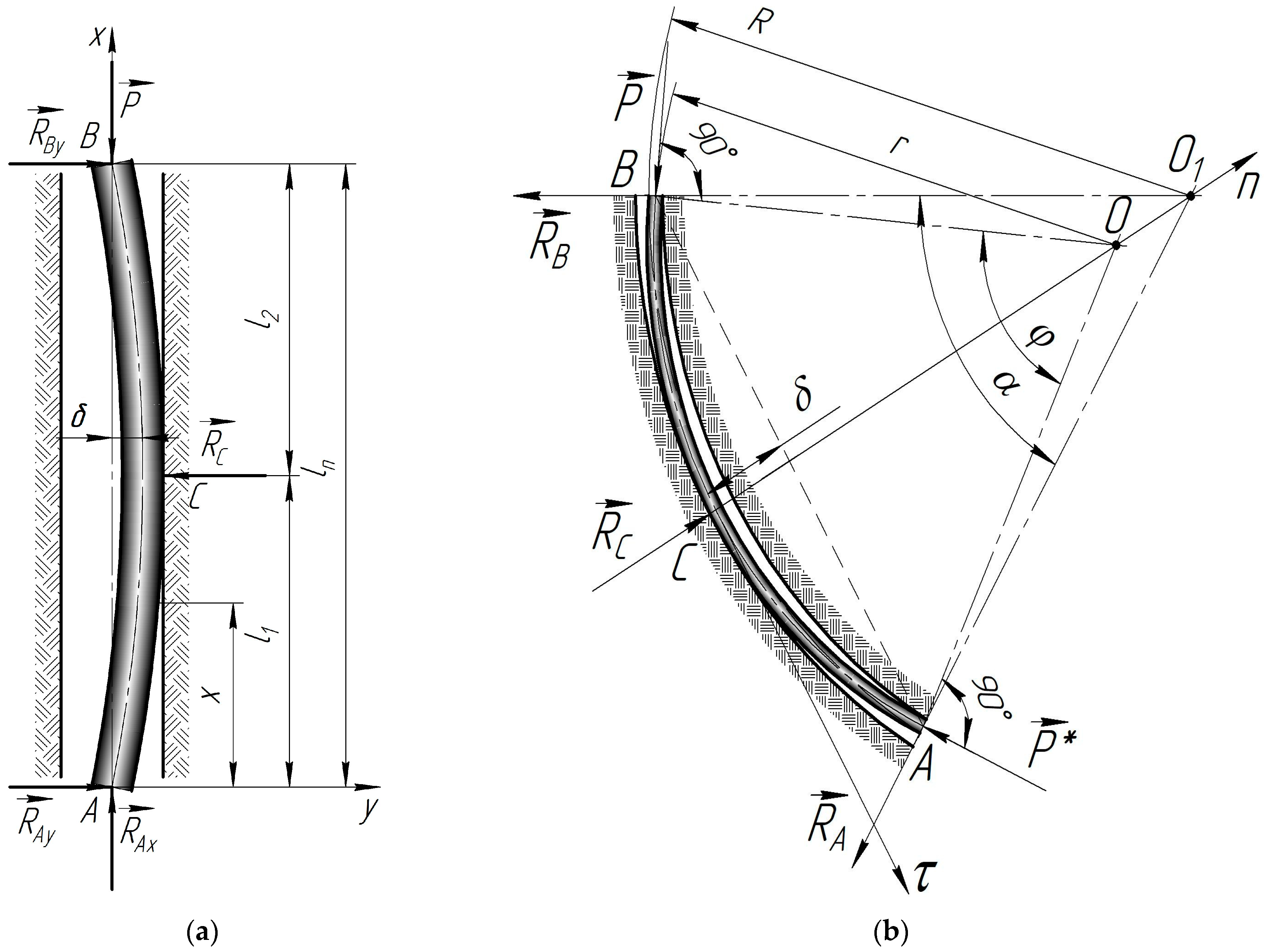
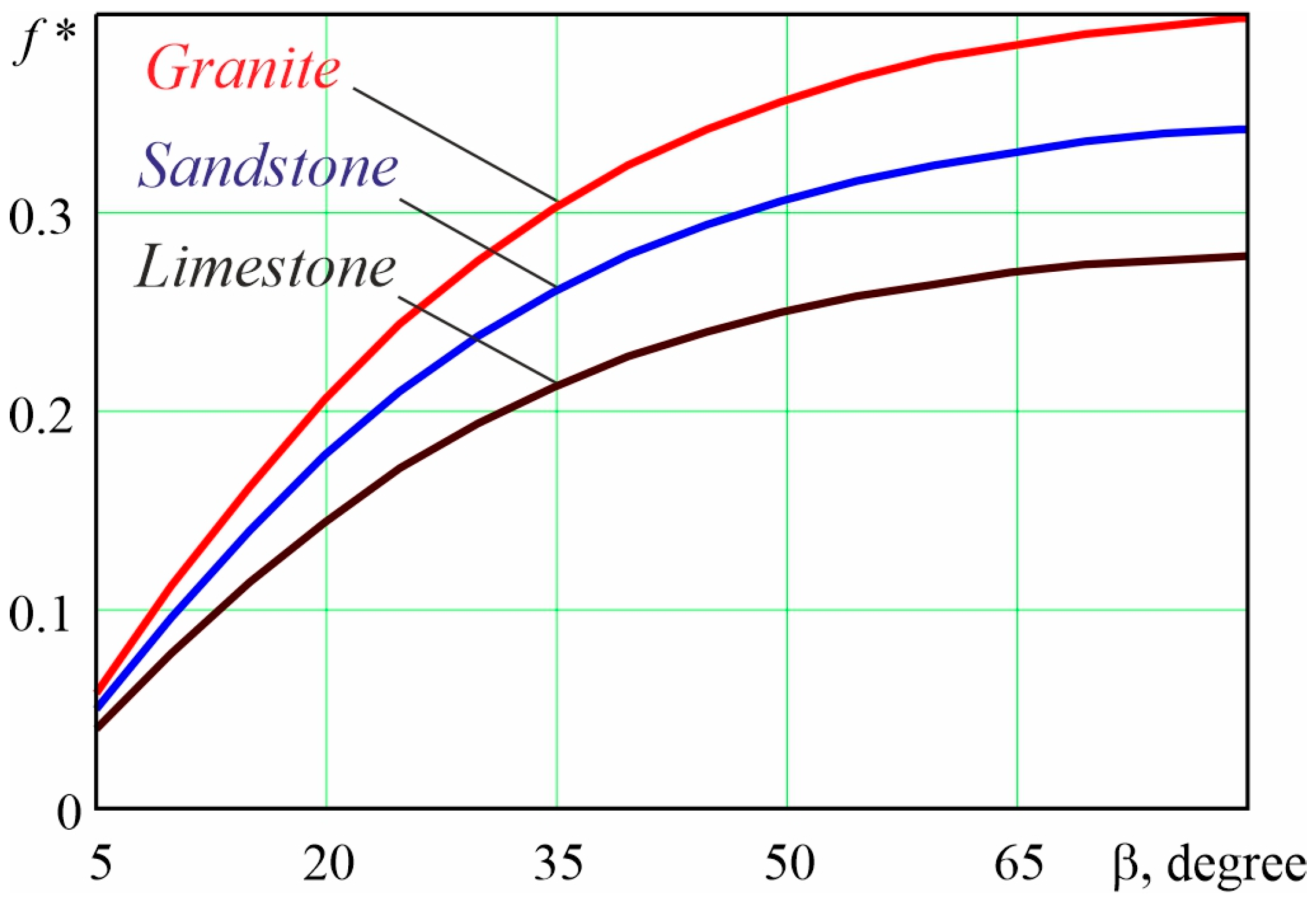
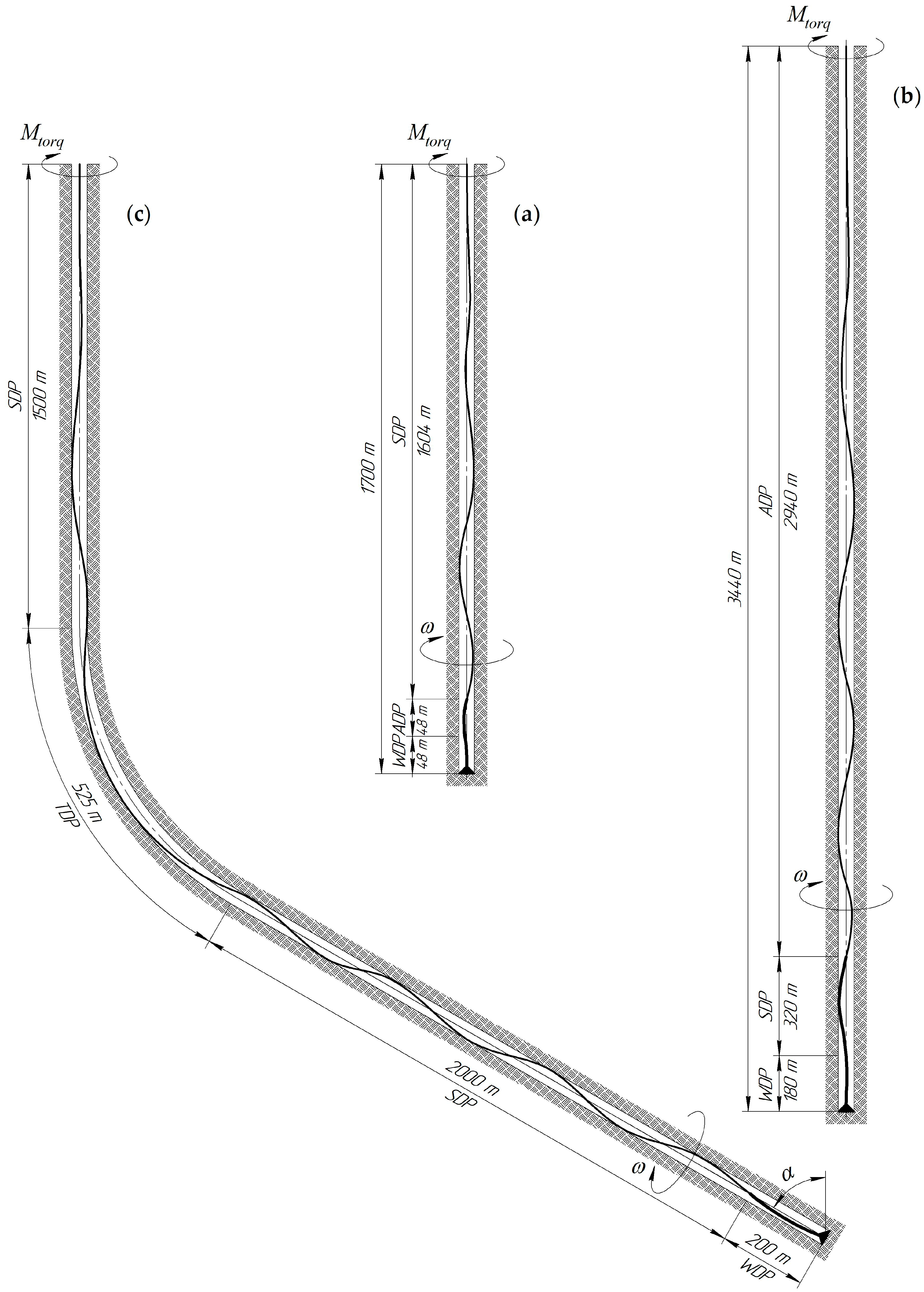
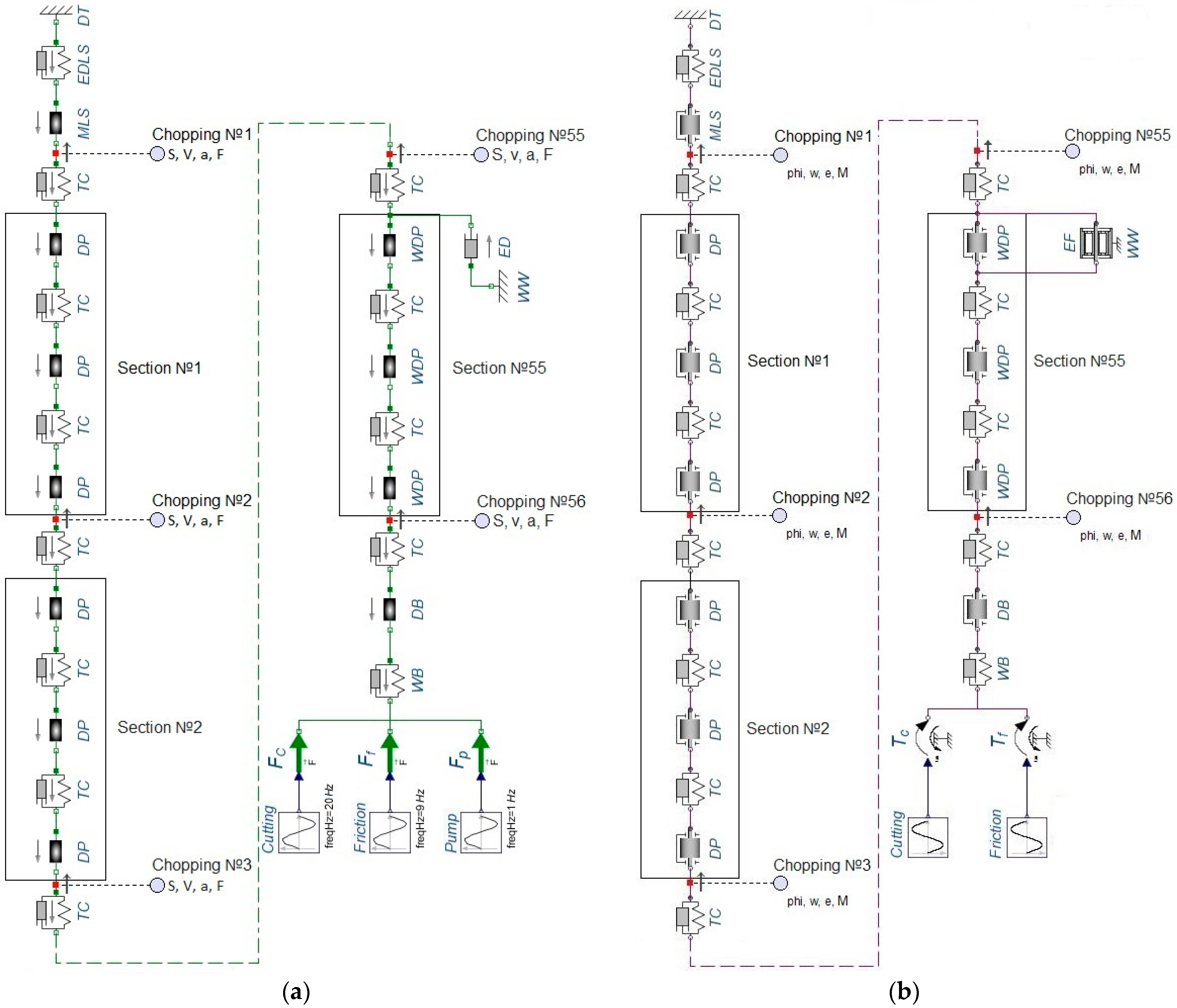
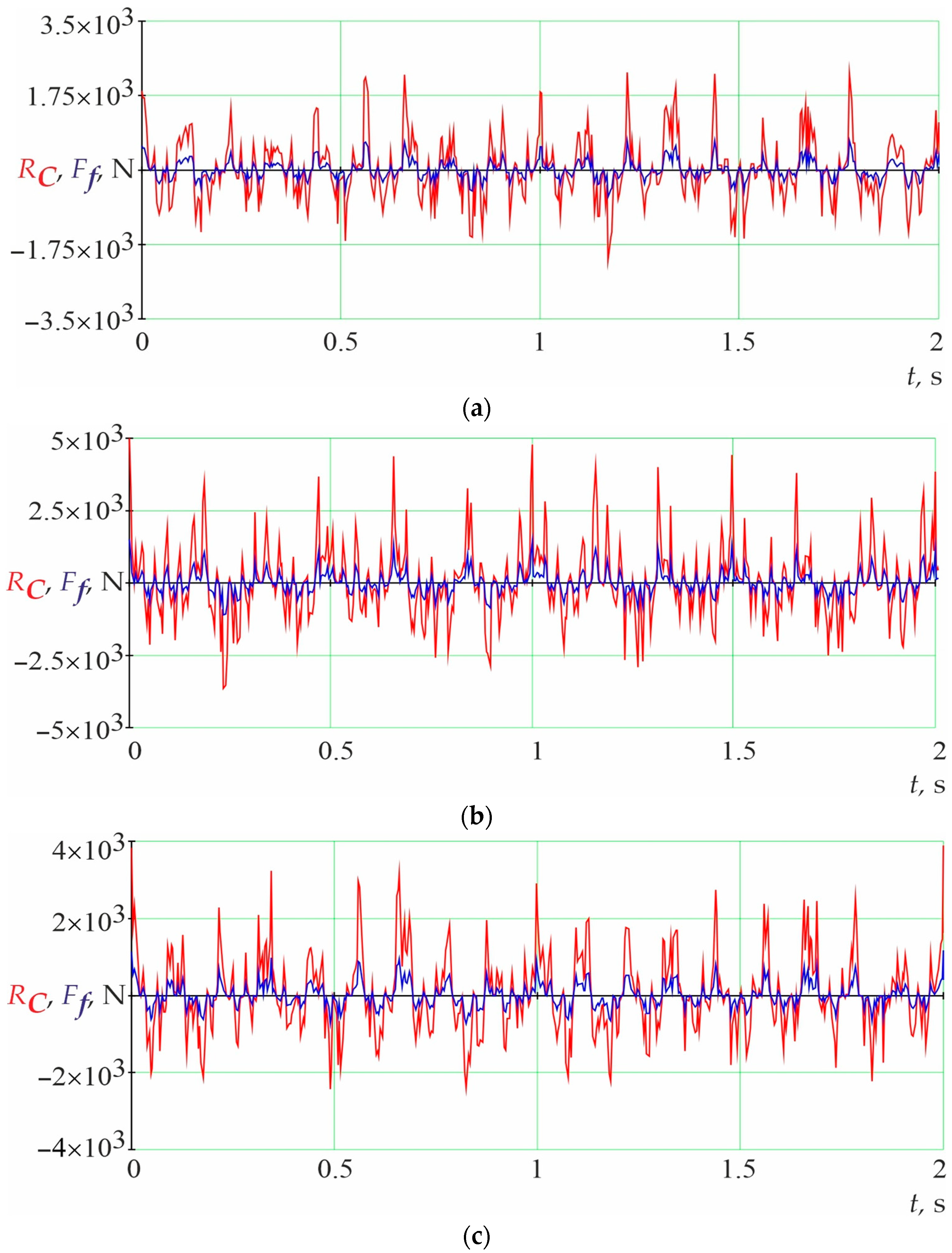
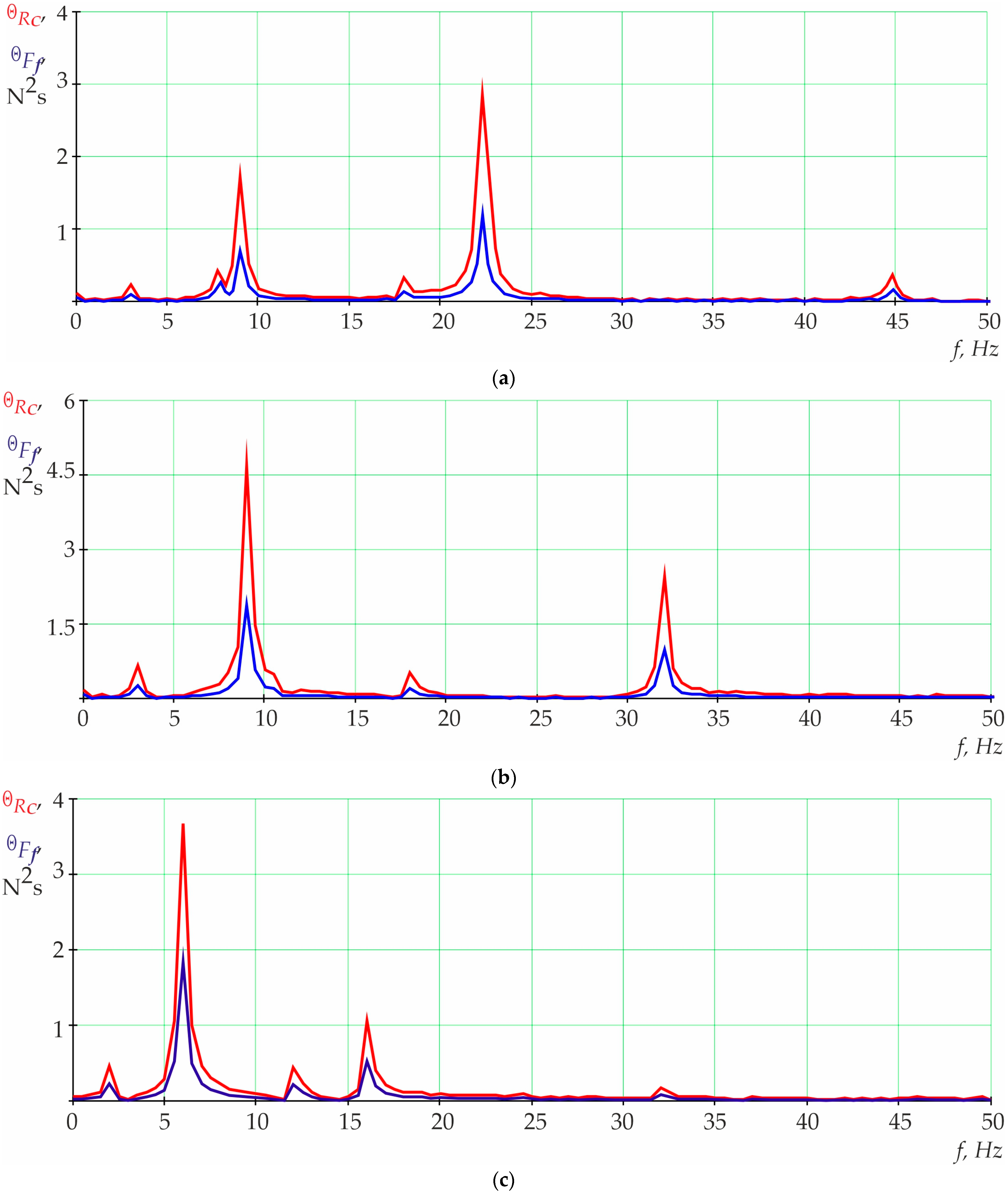
| Materials Drill Pipes | Ultimate Strength σUTS, MPa | Yield Strength σY, MPa | Relative Elongation δ5, % | Young’s Modulus E, GPa | Brinell Hardness HB | Density ρ, kg/m3 |
|---|---|---|---|---|---|---|
| D16T | 390–420 | 255–275 | 10–12 | 72 | 105 | 2770 |
| VT6 | 900–950 | 880–920 | 8–10 | 112 | 360 | 4450 |
| 36G2S | 686–862 | 490–755 | 11–12 | 200 | 317 | 7830 |
Disclaimer/Publisher’s Note: The statements, opinions and data contained in all publications are solely those of the individual author(s) and contributor(s) and not of MDPI and/or the editor(s). MDPI and/or the editor(s) disclaim responsibility for any injury to people or property resulting from any ideas, methods, instructions or products referred to in the content. |
© 2024 by the authors. Licensee MDPI, Basel, Switzerland. This article is an open access article distributed under the terms and conditions of the Creative Commons Attribution (CC BY) license (https://creativecommons.org/licenses/by/4.0/).
Share and Cite
Bembenek, M.; Grydzhuk, Y.; Gajdzik, B.; Ropyak, L.; Pashechko, M.; Slabyi, O.; Al-Tanakchi, A.; Pryhorovska, T. An Analytical–Numerical Model for Determining “Drill String–Wellbore” Frictional Interaction Forces. Energies 2024, 17, 301. https://doi.org/10.3390/en17020301
Bembenek M, Grydzhuk Y, Gajdzik B, Ropyak L, Pashechko M, Slabyi O, Al-Tanakchi A, Pryhorovska T. An Analytical–Numerical Model for Determining “Drill String–Wellbore” Frictional Interaction Forces. Energies. 2024; 17(2):301. https://doi.org/10.3390/en17020301
Chicago/Turabian StyleBembenek, Michał, Yaroslav Grydzhuk, Bożena Gajdzik, Liubomyr Ropyak, Mykhaylo Pashechko, Orest Slabyi, Ahmed Al-Tanakchi, and Tetiana Pryhorovska. 2024. "An Analytical–Numerical Model for Determining “Drill String–Wellbore” Frictional Interaction Forces" Energies 17, no. 2: 301. https://doi.org/10.3390/en17020301
APA StyleBembenek, M., Grydzhuk, Y., Gajdzik, B., Ropyak, L., Pashechko, M., Slabyi, O., Al-Tanakchi, A., & Pryhorovska, T. (2024). An Analytical–Numerical Model for Determining “Drill String–Wellbore” Frictional Interaction Forces. Energies, 17(2), 301. https://doi.org/10.3390/en17020301












